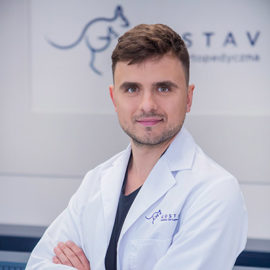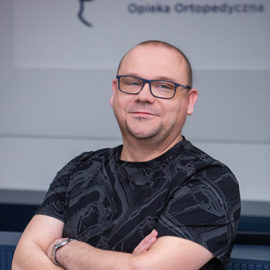-
Zadzwoń
509 105 905
22 100 12 36 -
ul. Białej Floty 2
02-654, Warszawa,
Mokotów -
Zapisy telefoniczne
pon - pt 8-19
-
Call us
509 105 905
22 100 12 36 -
Białej Floty 2 loc. 20
02-654, Warsaw,
Marina II -
Appointment registration
Mon - Fri 8-19
by phone
What does a preluxation clinic do? Hip ultrasound – preluxation study
Preluxation examination commonly referred to as“hip usg” is a test that every newborn should have. It is designed to assess the condition of the child’s hips and rule out abnormalities in the form of developmental hip dysplasia. For the evaluation of the hip in an ultrasound examination, a so-called “hip” is used. Graf scale.
When do we examine, how do we examine in a preluxation clinic?
The examination at our clinic consists of an ultrasound examination of the hip joints, a physical examination of the hips and a comprehensive evaluation of the toddler from an orthopedic point of view. During the orthopedic examination, among other things, the following are evaluated. The work of the joints, the proportions of the limbs, the inversion of the legs to the sides.
When is the check at the Preluxation Clinic?
As recommended by Prof. Graf’s first visit to a preluxation clinic is recommended by ca. 6 wks. life – that’s because when a defect is detected, early treatment significantly affects the length and effectiveness of treatment. If there is a family history of dysplasia, twin pregnancies or improper positioning of the baby in mom’s belly, it should be performed even earlier – at 2 or. 3rd week of a baby’s life.
Hip ultrasound – Assessment of the condition of the hips according to the Graf scale
To evaluate the hip in an ultrasound examination, a so-called “hip” is used. Graf scale. As recommended by Prof. Reinhard Graf’s first visit to a preluxation clinic should take place before the child is 6 weeks old – if a defect is detected, starting treatment early significantly affects its length and effectiveness. If there is a family history of dysplasia, twin pregnancies or improper positioning of the baby in the mother’s belly, it is advisable to visit at an even earlier date – at 1 or 2nd week of a baby’s life.
Graf proposed a division into four main types:
- Type I – properly formed hip joint, healthy hip
→ subtype lA
→ subtype IB
both are considered normal (they differ in the β angle reflecting the embracing of the femoral head by the articular rim)
- Type II – dysplastic or physiologically immature hip
→ subtype IIA (+) – do 3. month of life: fisiological delay in maturation of the hip with good bony formation of the acetabulum
→ subtype II A (-) – up to 3. Months of age: physiological delay in hip maturation with deficits in acetabular bone maturation
→ subtype IIB – after 3. Month of life: same hip characteristics as in type IIA
→ subtype IIC – at-risk or critical hip with a malformed acetabulum that, however, still includes the femoral head, the bony margin of the acetabulum is flat and the hip is prone to dislocation
→ subtype IID – the hip is similar in structure to IIC, but the head begins to decenter, resulting in elevation of the cartilaginous roof of the acetabulum
- Type III – decentered hip joint (dysplasia, abnormal alignment of the joint)
→ subtype IIIA – the head is displaced, the cartilaginous roof of the acetabulum is elevated, but without changes in its structure
→ subtype IIIB – displaced head and raised upward cartilaginous roof, with visible changes in structure
- Type IV -.complete deconditioning of the hip joint
Hip ultrasound – painless dysplasia prevention
- Preluxation examination has many advantages:
- is painless and completely non-invasive
- does not require major preparations
- is very sensitive: it allows to identify dysplasia even in cases where clinical examination does not show abnormalities
- allows for early diagnosis, which provides an opportunity to guide the development of the dysplastic hip to achieve a full cure.
Hip ultrasound at Gustav – Children’s Clinic, Warsaw, Poland
Ultrasound of the hip joint in infants allows for early diagnosis of hip dysplasia, which is the most common musculoskeletal defect occurring in children and in Poland occurs in approx. 4% of newborns. Detected early, it provides an opportunity to guide the development of the dysplastic hip to achieve a full cure.
Our doctors are trained in the Graf method, have had a tremendous amount of research done and many children cured of dysplasia. If dysplasia is detected at our clinic, we use the Tubinger orthosis, which has a proven track record, is well tolerated by children and does not cause difficulties in daily use.
Thanks to the cooperation with the “Coxis Foundation for the Prevention and Treatment of Hip Dysplasia,” parents of children with dysplasia can receive support in the daily care of their child during treatment.
The ultrasound itself does not take long, is non-invasive, requires little preparation, and the toddler is accompanied by the parents.
More about dysplasia and the course of the test is written in our blog by Dr. n. med. Łukasz Pulik:“Hip ultrasound in a newborn – why and when to perform it?“.
We invite you to the preluxation clinic at Gustav – Children’s Clinic in Mokotow, Warsaw.
Our orthopedic doctors

Jacek Kąpiński, MD
Orthopaedist
Maciej Ozonek, MD
Orthopaedist
PhD in Medicine Łukasz Pulik
Orthopaedist
Łukasz Jastrzębski, MD
Orthopaedist, Sports doctor
